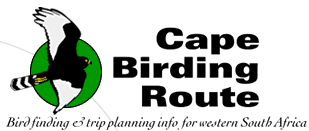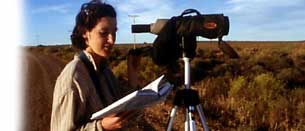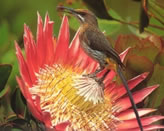|
Day
Guiding and Tours
We also offer variety of pesonalised
guided tours (day trips or longer), our guides being among
the region's most experienced birders. This includes set
tours or an individually guided day or two in search of
your most wanted species. Itineraries include these possible
day trips around Cape Town:
| Cape Peninsula
|
Fynbos and coastal endemics including Knysna
Warbler, Cape Sugarbird and African Penguin.
|
| West Coast |
Concentrates on the famous Langebaan Lagoon for
scrub and coastal birding - including shorebirds
and Black Harrier. |
| Tanqua Karoo
(2 day loop) |
The Tanqua Karoo is a superb birding area, offering
the majority of the Karoo desert endemics (including
Cinnamon-breasted Warbler and Karoo Eremomela) in
wonderful landscapes. |
| Overberg and Agulhas
Plain |
For a number of endemic species of grassland and
thicket, including Blue Crane, Stanley's Bustard,
Cape Vulture and the highly localised Agulhas Long-billed
Lark |
| Endemic Tours |
Day trip targeting Cape and Karoo endemics for
the dedicated birder. |
| Clean up tours |
Our guides will help you find your most wanted
species. |
Raptor
tours (2 days) |
See
20 species in 2 days, including all of SA's 5
bird of prey endemics - Jackal Buzzard, Pale Chanting
Goshawk, Black Harrier, Forest Buzzard & Cape
Vulture. Led by local raptor researchers. |
| Desert birding
|
Join us for 4-10 day tours into Bushmanland
and the Kalahari in
search of some of the more special endemics, including
larks and bustards. |
Sample day
trip itinerary
Tanqua Karoo Day (Cape Town - Ceres - Tanqua Karoo -
Cape Town)
The parched brown expanses, aloe-lined escarpments and
lonely isolated hills of the Tanqua Karoo provide an
apt setting for such fine and sought-after dry western
endemics as Karoo Eremomela, Cinnamon-breasted Warbler,
Namaqua Warbler and Fairy Flycatcher, among many others.
The steep, rocky slopes and dense acacia thicket of
the small picnic site of Skitterykloof (sometimes called
Katbakkies) offers fine and varied birding. These slopes
are also legendary as the most accessible site in the
world to see Cinnamon-breasted Warbler. Familiarity
with this species' call is absolutely essential, as
it is otherwise almost impossible to locate. A reticent
and little-known inhabitant of arid, rocky hill-slopes,
the Cinnamon-breasted Warbler is peculiar enough to
have been accorded its own genus. Its behaviour most
closely resembles that of shy and diminutive rockjumper,
bounding about sun-baked boulders and calling fervently
before inexplicably disappearing for long periods.
Other species that we hope to encounter here are Black-headed
Canary (nomadic) Southern Grey Tit, Layard's Titbabbler,
Mountain Chat and Grey-backed Cisticola. Pale-winged
Starlings regularly overfly the valley, and Ground Woodpeckers
sometimes hurl invective from the ridges. As ever, it
is worth keeping an eye skyward for the likes of Black
and Booted Eagles and Rock Kestrel. The acacia thicket
in the picnic site is usually alive with birds, even
at midday. The essentials here are Fairy Flycatcher
and Pririt Batis (p. 00). Other interesting birds of
this habitat are Pied Barbet, White-backed Mousebird,
African Marsh Warbler (summer), White-throated Canary
and Cape Bunting.
Emerging from the hills and onto the semidesert plains
of the Tanqua Karoo, one enter a whole new habitat for
birds - where almost everything is an endemic! We'll
take the R355 to Calvinia, notorious as the longest
road in South Africa uninterrupted by a town (250 km
in all). Common birds of the relatively moist scrublands
just north of the road fork are Pale Chanting Goshawk,
Karoo Lark, Karoo Chat and Yellow Canary. We'll also
search for Karoo Eremomela. A co-operative breeder,
it occurs in small, agitated flocks that remain constantly
on the move, thoroughly gleaning low bushes before the
birds follow each other onwards. Other typical birds
of this habitat are Karoo Lark, Karoo Chat, Rufous-eared
Warbler and Grey-backed Cisticola.
As we head north bushes are few and far between and
the ground gleams with the mineral patina of the desert
pebbles. This is classic Tractrac Chat country: birds
are most often spotted, as they flush near the road
and display their white rumps as they fly a short distance
to perch, again on a fence or low bush. Spike-heeled
Lark is also regularly seen. From this point on, we'll
keep alert for Black-eared Finchlark, a nomadic species
found throughout the Karoo and which often moves around
in flocks. While driving, you are likely to spot the
conspicuous, all-dark males fluttering over the road,
although they invariably land frustratingly behind the
bushes by the time you've stopped the car! It is worth
keeping an eye out for pairs of superbly camouflaged
Karoo Korhaans. Pale Chanting Goshawks are reasonably
common throughout the Tanqua Karoo, and Greater Kestrels
frequently wander into the area. If we are lucky enough
to visit after recent rain, you will see that pools
forming close to the road invariably attract South African
Shelduck, drinking flocks of Namaqua Sandgrouse and
irruptive seedeaters such as Lark-like Bunting. We'll
also search for Namaqua Warbler in the watercourses.
Formerly classified as a prinia, this species has recently
been assigned its own genus, Phragmacia, picturesquely
named after its habitat of mixed Phragmites reeds and
Acacia thicket. It is a much more secretive bird than
the similar Spotted Prinia, but every bit as noisy.
If we're really fortunate, we may even spot a Burchell's
courser on the plains in some of the areas where we've
seen them in the past.
Accommodation
Over years of birding experience in the area, we have
selected a handful of birder-friendly guest houses and
lodges along the route which we can recommend. The accommodation
is selected on the level of service and hospitality,
country charm, the fantastic settings and adjacent birding
opportunities. We can book accommodation from Cape Town
to the Kalahari, and a few highlights from our collection
are included on the pages of this site. Go to Cape Birding
Route > Accommodation
for more.
Costs
Please contact us
to cost your personalized trip.
|


